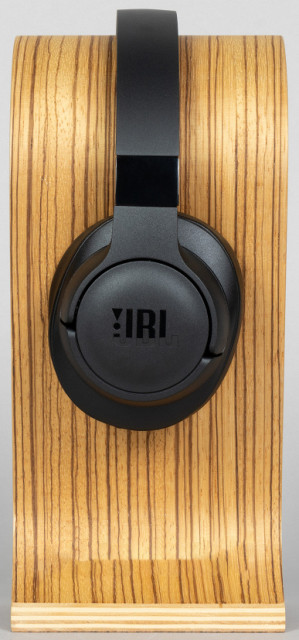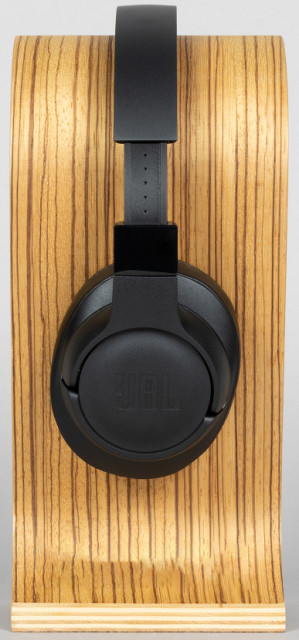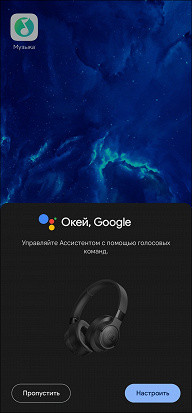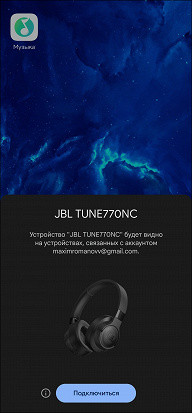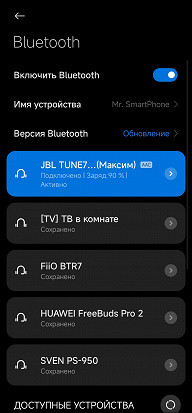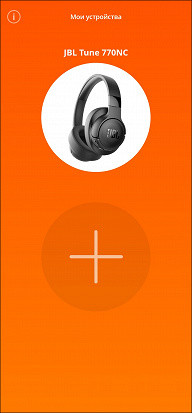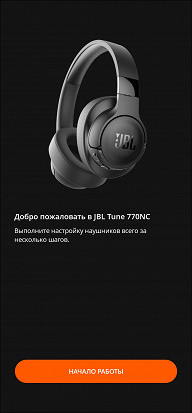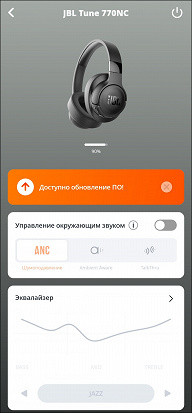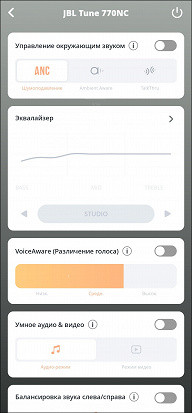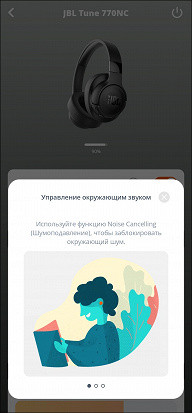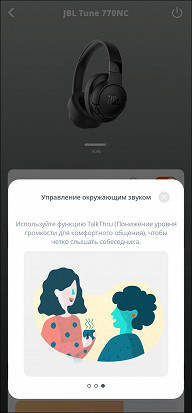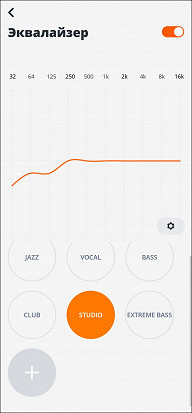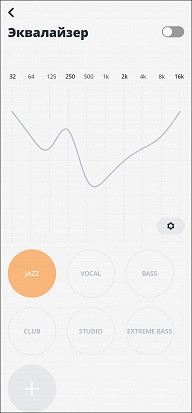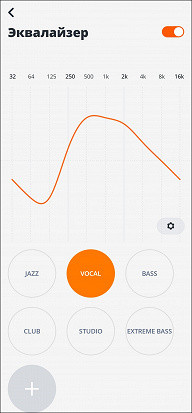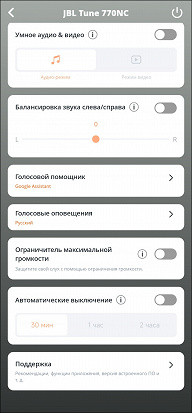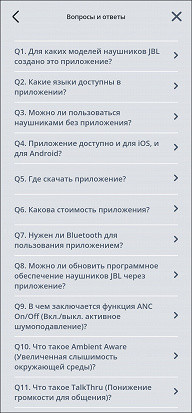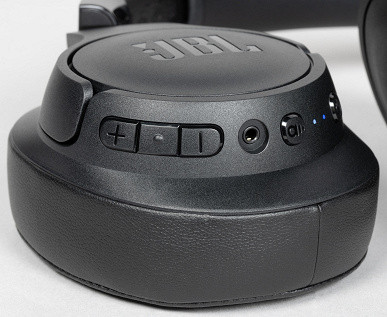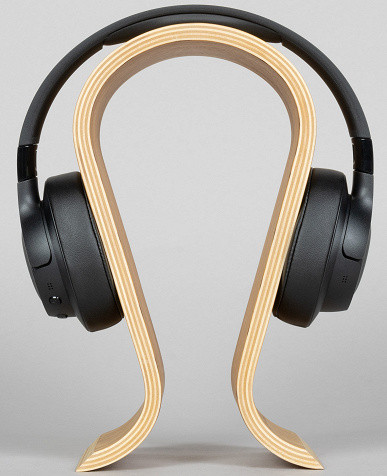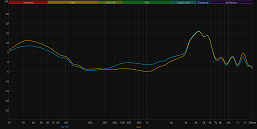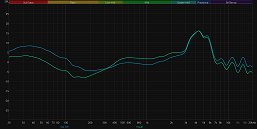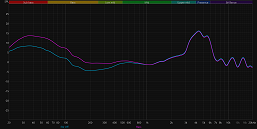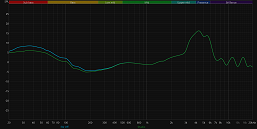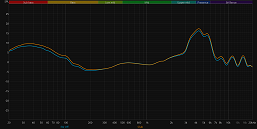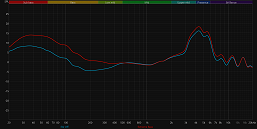We continue our quest to find inexpensive but high-quality over-ear headphones. In this search, we paid attention to the QCY H2 model, which was available for less than a thousand rubles and was popular. However, testing has shown that the sound quality of these headphones leaves much to be desired.
Despite the bad experience with the QCY H2, our interest in QCY as a manufacturer of budget headphones did not fade, and we tested their new H3 ANC model, which cost approximately 3 to 4 thousand rubles. These headphones were a little more advanced, equipped with active noise cancellation, and sounded quite acceptable for casual users.
Then we tested the Commo One headphones from Yandex Market, which initially cost about 4 thousand rubles, and at the time of preparing the review a little less than 5 thousand. It was a good option for the price, with a nice design, a comfortable fit and good sound, although without active noise cancellation.
However, we continued to look for headphones with even better sound and functionality, and looked at models up to about 7 thousand rubles. In this range, we looked at numerous JBL over-ear headphones and focused on the JBL Tune 770NC, which featured active noise cancellation and promised decent sound for the price.
Specifications
| Declared frequency range | 20 Hz — 20 kHz |
|---|---|
| Impedance | 32 Ohm |
| Sensitivity | 100 dB at 1 kHz |
| Speaker | ∅40 mm |
| Connection | Bluetooth 5.3, wired |
| Supported codecs | SBC, AAC |
| Multipoint | There is |
| Control | mechanical buttons |
| Noise suppression | There is |
| Battery capacity | 690 mAh |
| Charging connector | USB-C |
| Battery life | up to 70 hours without ANC |
| Charging time | 2 hours |
| Fast charging | 5 minutes for 3 hours of work |
| Weight | 232 g |
Packaging and accessories
The packaging design of JBL products has been familiar to fans of the brand for many years, and it remains attractive. Bright illustrations, images of the device, brief characteristics and loud slogans — everything is in its place. Inside, the headphones are neatly packed in a fabric bag and secured with a cardboard holder, so their safety during transportation is beyond doubt.

The package includes the headphones themselves, documentation, a USB-A to USB-C charging cable, and an audio cable for a wired connection to a sound source.
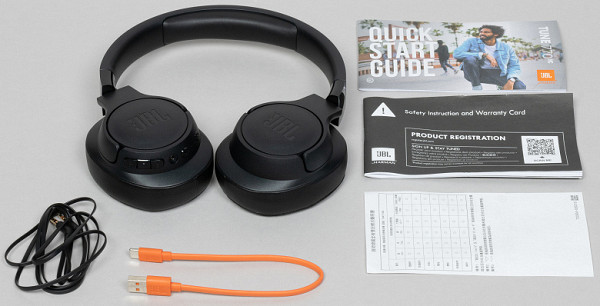
The charging cable is of good quality and, traditionally for JBL, painted in bright orange. The length is small — only 25 cm.

The audio cable is equipped with two connectors at the ends: a minijack (larger, 3.5 mm), which connects to the sound source, and a microjack (smaller, 2.5 mm), designed to connect to headphones. The connectors feature a logo and the dielectric spacers on the plug are orange for a nice aesthetic appearance. The cable itself is flat, flexible and thin, which raises doubts about its reliability, but these concerns are not confirmed during use. The cable length (125 cm) is sufficient for comfortable use.
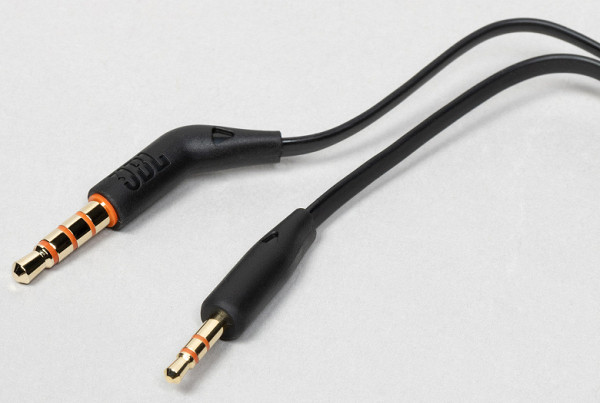
Design and construction
The JBL Tune 770NC is available in four different color options: classic black and white, as well as blue and lilac. For our testing, we chose a strict black color. The design of JBL headphones remains almost unchanged not only between generations, but also between different models. This recognizable style has been visible for many years. While conservatism in design isn't necessarily a bad thing, it would still be interesting to see more progressive changes in the new models, as well as more noticeable differences between devices at different price points.
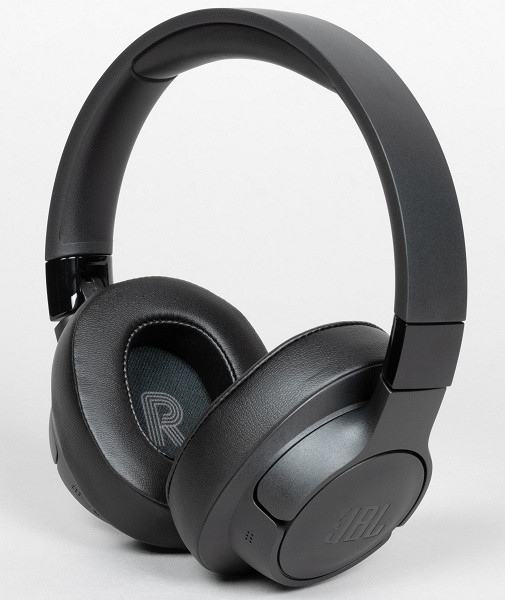
The design of the JBL Tune 770NC is kept in a strict and laconic style, which makes them universal and suitable for any look — be it a sports suit or a business outfit. The headphone body is made entirely of plastic, which is typical for models in this price category. While the plastic doesn't give them a «premium» feel, they still look quite solid thanks to the matte finish that's resistant to finger smudges.

There is a large glossy JBL logo on the earcups, which stands out against the matte surface and slightly disrupts the overall rigor of the design. Perhaps if the manufacturer had limited itself to a less prominent placement of its logo, for example, on the temple, this would have made the device even more versatile in combination with various types of clothing. However, this is a minor detail that should not be paid too much attention to.

JBL Tune 770NC headphones are foldable, which is very convenient and functional. We really needed this option, especially considering that other models, such as the Commo One, do not have this option. By folding the headphones, they can easily be placed in a small pocket of a backpack or bag, which is sometimes very convenient. However, it is worth remembering that the headphone body is made of plastic, so care should be taken during transportation to avoid damage to the mounts. In this case, you can also consider the possibility of additionally purchasing a hard case, of which there are many on the market, including at an affordable price.
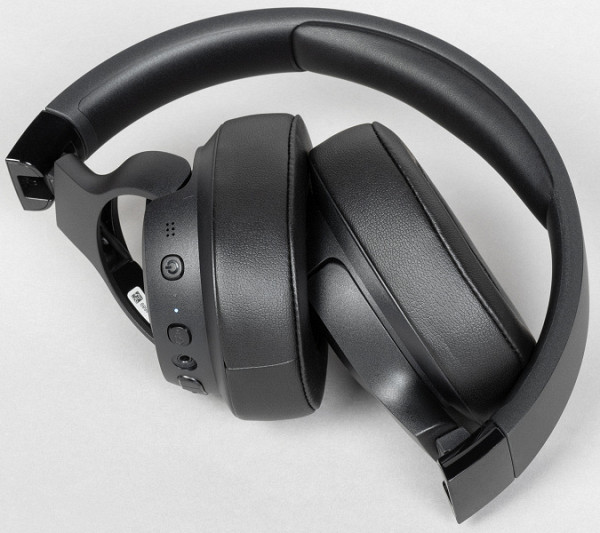
The earcups of the JBL Tune 770NC headphones can be rotated 90° in one direction and approximately 10° in the other. This not only makes the headphones fit more comfortably, but also allows you to wear them around your neck when not in use.
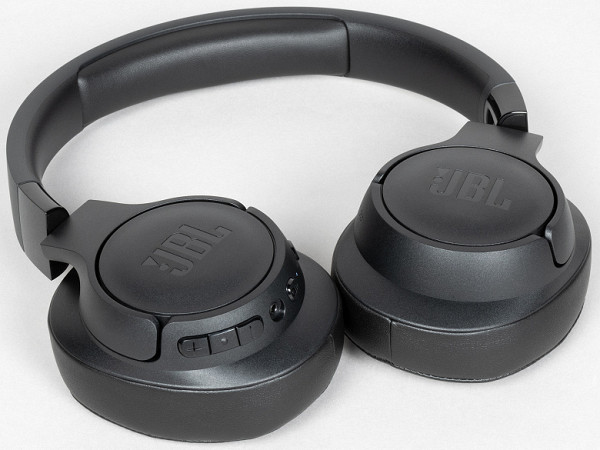
The retractable part of the headband is also made of plastic, which emphasizes the budget nature of the headphones. However, this does not cause serious inconvenience, and the build quality of this unit leaves a good impression — reliability and lack of play were noticed throughout the entire testing period.
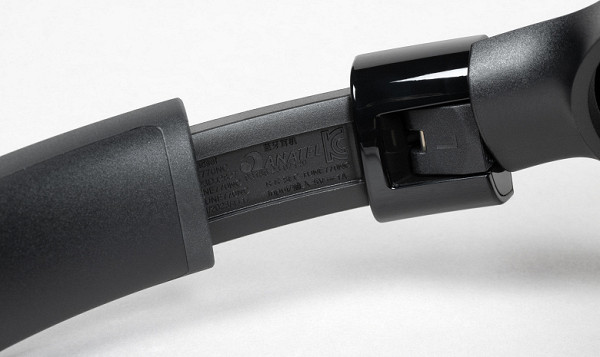
The adjustment mechanism is stepped with 13 positions on each side, including the extreme ones. The movement is accompanied by a noticeable click, and the fixation in each position is reliable.

The cups have 3.5 cm of travel on each side, allowing the headband size to adapt to virtually any head.
On the inside of the headband there is a soft faux leather pad filled with foam material. Although the size of this pad is small compared to other headphones, it does the job quite well. However, people with large heads may not be very comfortable. The device control buttons are located on the bottom of the right cup.
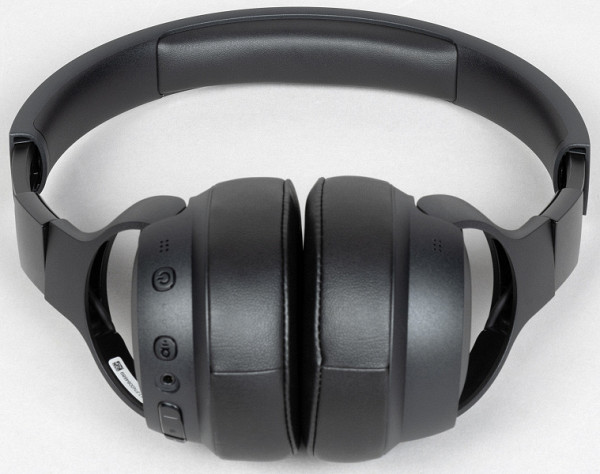
On the side surfaces of the cups facing the mouth when wearing headphones, holes are visible, behind which microphones for voice communication are hidden.
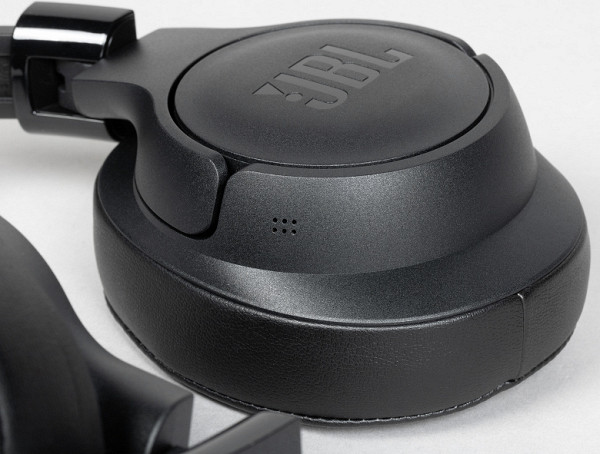
The ear pads are made of artificial leather, with soft foam filling inside. The fabric covering the speaker grilles is marked with “right”/“left” designations.

The power connector is located on the top side of the right cup under the arc designed to attach it to the rim. There is a small LED indicator next to it. This is not the most convenient place to place the connector, which can make it difficult to connect the cable. In addition, this arrangement does not provide protection from moisture, which can be problematic in the event of even light rain. It is also worth considering that next to the connector there are compensation holes designed to relieve excess pressure when the speakers are operating. Although the manufacturer did not claim moisture protection, it would be better if the design did not have such obvious “weak points”.
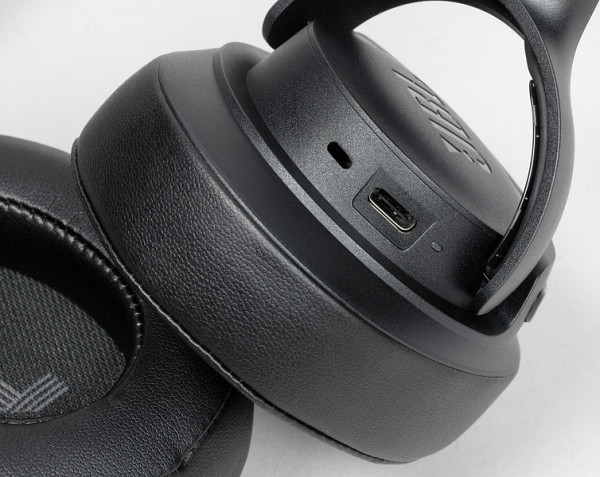
Apparently, it is not possible to remove the ear pads, or removing them could damage the design. Given that the headphones aren't very expensive, it's likely that few people will try to replace the ear pads. It may be easier and more efficient to replace the entire device. So there's not much room for criticism here.
Connection
When you turn on the JBL Tune 770NC for the first time, pairing mode starts automatically. To activate it, you must hold down the power button again (after turning off the device). The headphones also support Google Fast Pair, which makes the process of connecting to Android devices quick and simple: a window appears asking you to connect, just agree and wait. The user can also configure the voice assistant. In addition, it is possible to use a standard connection through the smartphone menu.
We traditionally received a complete list of supported codecs and their modes using the Bluetooth Tweaker utility. There are only two of them — SBC and AAC, which is enough for a budget headset.

The maximum Bitpool setting for SBC is set to 46, while the recommended High Quality profile is set to 51. This means that the codec will work almost at its maximum capabilities, providing high-quality sound. The manufacturer probably made this decision in an effort to ensure stability and quality of communication with the sound source. As for AAC, the upper bitrate limit is set at 262 Kbps, which is even higher than the standard 256 Kbps. The headphones support multipoint and can work with two sources simultaneously, and moving between them occurs correctly.
Wired connection is simple and intuitive: simply connect the cable to the headphones and then to the source. Wired connection is supported in both passive and active modes, while noise reduction remains available in active mode. The call quality is good, and the headphones demonstrate stable performance in various conditions. At times there may be a slight desync between audio and video when watching a video, but this can be resolved by activating the «smart audio and video» mode, which dynamically controls the bitrate of the audio stream.
An important step in preparing to use headphones is to install the JBL Headphones application, without which full use of Tune 770NC is impossible. After connecting the headphones, they immediately appear on the main screen of the application, and the user is asked to go through basic setup, including choosing a voice assistant.
Next, we quickly read a few recommendations for using noise reduction and end up on the main screen. A banner awaits us indicating the availability of a firmware update.
Let's update — this is a necessary thing. The whole process in our case took about five minutes, after it was completed the headphones rebooted and were ready for use again.
Management and software
The first module on the device's screen allows you to control ambient sound, including active noise cancellation and sound transparency mode. In Audio Transparency mode, the headphone microphones transmit external sounds to the speakers. There are two transparency options available: normal and conversation mode, which emphasizes the midrange for better voice intelligibility.
Then comes the most important thing — the equalizer. It is noted that JBL Tune 770NC is recommended for use with an equalizer. The device has several built-in presets, as well as the ability to create your own settings using 10 frequency bands.
The Smart Audio & Video feature is similar to what many other manufacturers call Game Mode. Its purpose is to eliminate desynchronization of sound and image when watching videos and playing games, usually this is achieved by reducing the bitrate.
We also set the voice notification language to Russian. However, it turned out that the names of functions, such as «AmbientAware» and «TalkThru», are still pronounced in English, but with a not very pleasant accent. Messages in English sound a little better and more pleasant, but this is a matter of taste, of course.
At the bottom of the screen you can select a voice assistant, limit the maximum volume and set the automatic shutdown time when inactive. In the «Support» section you can find a short guide and answers to frequently asked questions in Russian, which is nice.
Control is carried out using mechanical buttons on the right cup. This is the best choice for inexpensive headphones, as the use of touch elements in budget products often results in insufficient reliability and comfort. The buttons are easy to press with a noticeable click, making use pleasant.
Control of volume and scrolling of tracks is made in the form of a “swing”, in the center of which there is a universal key. There is a convex dot on the key that makes orientation easier by touch.
Management is conveniently organized and logically structured. The ability to adjust the volume and switch tracks is provided, which makes the control process as complete as possible. The instructions contain visual diagrams that show which key is responsible for which function for different types of presses.
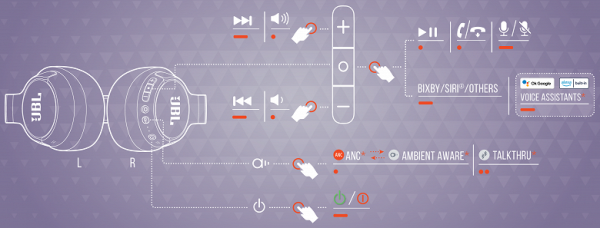
Control of the headphones is generally convenient, with the exception of one strange moment. You can't turn off noise reduction using the button on the headphones — you can only switch between the «noise reduction» and sound transparency modes. You can only disable ANC through the app, which can be inconvenient if you need to quickly switch between modes without access to the device.
Exploitation
The fit of the JBL Tune 770NC is truly different from the standard ones. The internal size of the ear pads is only 54x37 mm, which makes them close to on-ear headphones. This can create pressure on the ears, especially with prolonged use, given also the tightness of the headband and the medium-quality leatherette material of the ear pads, which heats up quickly.
However, this close-fitting design provides excellent passive noise isolation, making active noise cancellation often unnecessary. This also means that people around you won't be able to hear your music preferences unless the volume is turned up to maximum.
The headphones fit well on your head, making them comfortable for sports, although comfort decreases over time.
It should be noted that they are not waterproof, which makes them less suitable for outdoor use in the rain.

The internal travel of the headband reaches 35mm on each side, providing plenty of room to adapt to different head sizes. Even so, the ear pads will exert higher pressure than most other headphones we've tested.
The JBL Tune 770NC's noise cancellation works well against low-frequency sounds, such as the hum of engines or crowds. However, when people around are talking loudly, its effectiveness decreases. At the same time, thanks to excellent passive sound insulation, the use of noise reduction is less often required, which is convenient for long-term wearing of headphones.
Sound Transparency mode is useful for monitoring the situation around you. The “TalkThru” option is especially useful, which improves the perception of the voices of others. Although long conversations without removing the headphones are inconvenient and impolite, quickly exchanging a few phrases is still possible.
Microphone for voice communication
The manufacturer JBL does not provide detailed information about the microphones built into the headphones, which raises interest in their operation. To measure the characteristics of microphones, we use a specially prepared room and a monitor speaker system to reproduce sweep tones. Measurements are carried out using a calibrated measuring microphone to obtain a graph of the speakers' frequency response, which is then used to adjust the profile and compensate for acoustic features. The signal is recorded using the microphone under test, located in the same position as the measuring microphone. The resulting graph is adjusted taking into account a previously created profile, which allows you to obtain the characteristics of the microphone under test.

The JBL Tune 770NC microphone is tuned to emphasize the low-frequency sounds of the voice, which helps convey its characteristic features. Although the low frequencies are smoothed out, this helps preserve the clarity and dynamics of the voice without losing important aspects of the sound. However, there is some emphasis on the midrange, which can make the sound sound a bit unnatural, particularly reminiscent of a telephone-like sound. However, the voice remains quite intelligible and understandable, making these headphones acceptable for general voice communication and recording voice messages.
Although the active noise cancellation system is not specifically designed for calls, the results of its use were impressive. Voice transmission remains clear in noisy environments, and background noise has little effect on the perception of the recorded voice. This indicates the high quality of the microphone and its ability to provide clear and clear voice transmission even in difficult conditions.
Autonomy and charging
The declared battery life of the JBL Tune 770NC is up to 70 hours without activating the noise reduction system and up to 44 hours with the noise reduction function enabled. These numbers are impressive, although recently many budget headphones have been boasting long battery life — for example, the recently tested Commo One claimed up to 95 hours (although in practice the result was slightly less). Typically, actual operating times are slightly lower than advertised, since manufacturers usually report test results under ideal conditions, while our tests tend to be closer to real-world conditions.
It is important to consider that the safe sound pressure level when listening to music is about 75 dB, but many users prefer to listen to music at a level of 90-100 dB. To measure headphone operating time, we use white noise and record the sound pressure level at about 95 dB, after which we record the operating time of the headphones using a measuring stand.
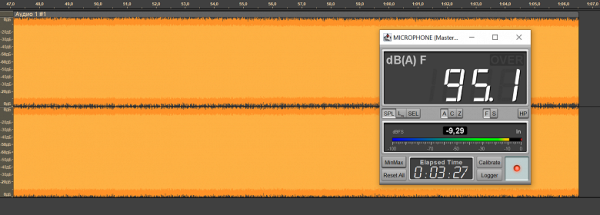
This test was really long. Without activating noise cancellation, the headphones lasted 62 hours — this is a little less than stated, but still very impressive. If you use the headphones for several hours a day, you will only need to charge them a couple of times a month. Enabling the noise reduction function almost equalized the battery life with the declared level — 40 hours. This is quite enough for comfortable use.
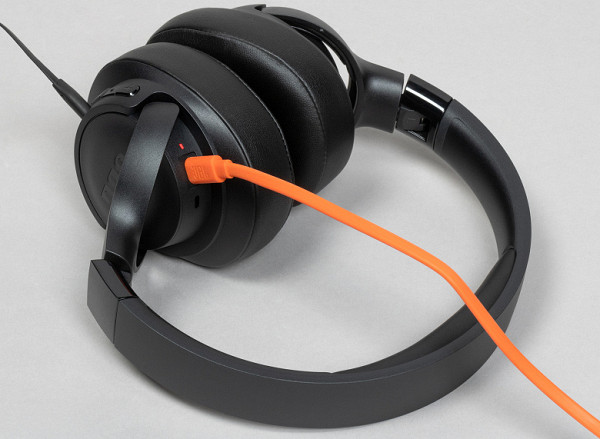
It takes 2 hours to fully charge the headphones from scratch, but they also claim the ability to quickly charge — 3 hours of work in 5 minutes. In our tests, a quick charge lasted about 2.5 hours, which is a little shorter but still quite satisfactory. So you won’t have to remain without music and communication for a long time; the main thing is to have a power source and cable at hand at the right time.
Sound and frequency response measurements
The manufacturer of JBL Tune 770NC places special emphasis on the presence of the so-called “JBL Pure Bass”. Indeed, there is plenty of bass in them, the emphasis on it is very pronounced — sometimes even too much. The low-frequency range remains surprisingly “biting”, with good attack and almost no “booming”. The “deep” bass is further emphasized by the dip in the upper part and lower middle — in the region of 200-300 Hz, although this does not have the best effect on the naturalness and fullness of the sound. But the middle is more or less “smooth” and well readable, which in this case we did not really expect.
In general, initially the JBL Tune 770NC are headphones for avid bass lovers who prefer electronic music with pronounced sub-bass. Let's illustrate this using a frequency response graph, starting with the Bluetooth connection.

The presented frequency response graph is accompanied by a background target curve developed by the manufacturer and adapted for a specific device, similar to the so-called “Harman curve”. This curve takes into account differences in the perception of different frequencies by different people, thereby compensating for their impact on the actual user experience. The sound close to the target curve is considered neutral, balanced, natural, etc. The given frequency response graph after compensation corresponds to this target curve, which allows you to present the subjective listening impressions as accurately and clearly as possible.
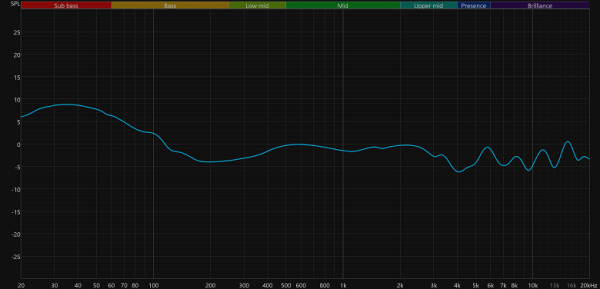
Let's compare the graphs obtained in three connection modes: wireless, wired on and off. Each of them presents a pronounced “deep bass”, a slight dip in the lower mids and a fairly smooth presentation of the midrange, which is clearly visible in the graphs.

Comparison of the sound in wired and wireless modes shows minor differences, indicating the use of built-in DSP to enhance the bass. However, in passive mode, the lower bass range is less pronounced, while maintaining a dip in the lower mids, likely due to the design of the headphones. For greater clarity, let’s compensate the frequency response graph in passive mode according to the target curve. We get slightly enhanced bass and an almost flat midrange, although small dips at the edges of the midrange can be frustrating.
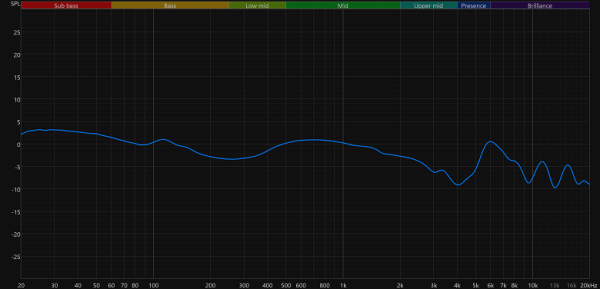
Active noise cancellation systems tend to have a negative effect on bass reproduction. In this case, the situation is similar, but due to the excess of bass, a slight decrease in its emphasis will not cause harm, but, on the contrary, may even be more preferable.
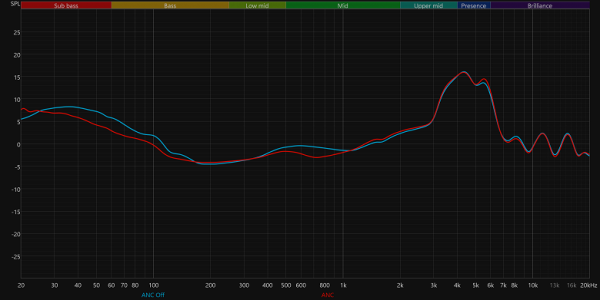
Let's look at what effects the equalizer presets demonstrate. In general, they are all logical and correspond to their names: for example, the Vocal mode highlights the middle of the frequency range. For fans of extreme bass, there is an Extreme Bass mode that further enhances the already forward low frequencies. If you want to feel every kick in a techno track right in your skull, you can try this mode. However, don't get too carried away with it.
The most attractive and interesting of all the presets is definitely Studio. It slightly corrects the frequency response curve and reduces the emphasis on low frequencies. Let's look at its graph against the background of the target curve. This sounds more like a sound that might appeal to people who aren't fans of loud bass.

But we have the ability to create our own sound profiles. We take the equalizer and drastically reduce the bass level. We lower the lowest frequency part of it to the limit. This may look quite drastic on screen, but it actually claims a 5dB reduction at the lowest setting of the control.

It's simple and effective, and the results are pleasantly surprising. The sound is evened out, becomes more pleasant and easily perceived. I would like to correct other shortcomings, but even with 10 stripes this turns out to be not enough — in the end, it seems that “we are treating one thing, crippling another.”
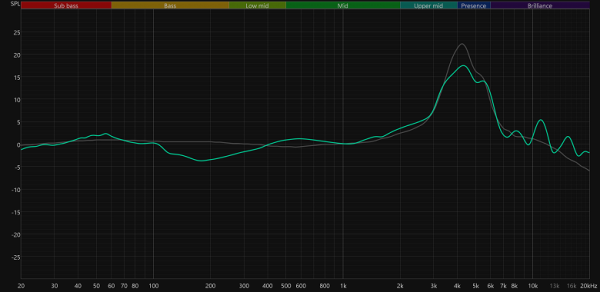
Let's adjust the graph according to the target curve. Light, enhanced bass, almost flat mids — that's all you need. The dip in the lower middle, unfortunately, remains, but is not too worrying. With less pronounced bass, the high-frequency range may seem harsh — it can be softened a little, but it is important not to overdo it.
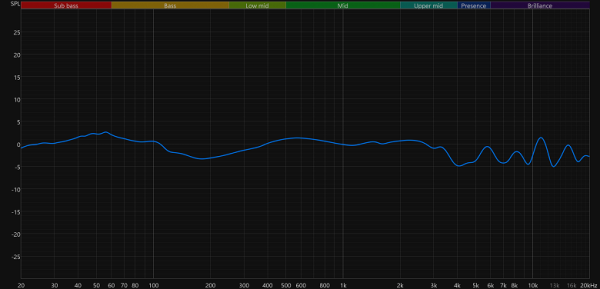
In the beginning, the sound path of headphones is quite unique, and therefore the use of an equalizer is clearly necessary. With its help, you can significantly change the sound reproduction — the example presented above only demonstrates the possibilities. However, the main thing always remains the personal perception of sound by each listener.
Results
The JBL Tune 770NC are headphones with a distinct character that inspires many different opinions. However, with some minor adjustments the sound becomes more acceptable, especially considering their affordable price. The fit may not be the most comfortable, but it is secure, providing excellent sound insulation. The controls are convenient, except for the inability to completely turn off noise reduction. Active noise cancellation doesn't work perfectly, but it doesn't cause much discomfort. Overall, these headphones offer good value for the price, although it's up to each user to determine whether they're willing to accept their trade-offs.

